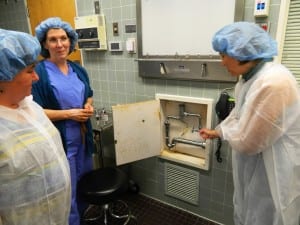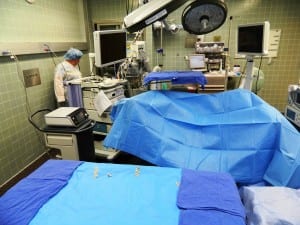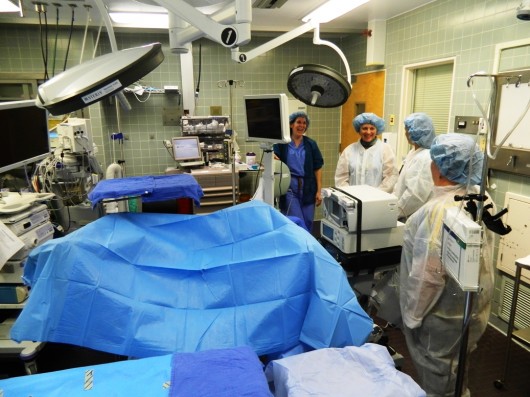Hospital facilities throughout Southeast Alaska are getting old, with many closing in rapidly on 50 years since they were built. Health care has changed quite a bit in the past half-century, and communities are facing expensive upgrades to keep up with those changes into the future.
This report, part of CoastAlaska’s series taking a look at health care in Southeast Alaska, focuses on Ketchikan’s plans for an extensive remodel of its community hospital.
If you appreciate 1960s interior design elements, Ketchikan Medical Center’s surgery rooms are for you. The cramped spaces are tiled in vintage green. And while there have been some upgrades in the past half-century, it still looks like the set for a movie based in a bygone era.
Kim Schwartz, surgical services manager, showed a small group of visitors a vintage item left over from the original construction. She opened up a little door in the wall, and said, “Does anybody know what that is? What it is, it’s suction. What you’d do is turn on water, water would go down though here, you have a hose on here and creates a vacuum.”
Penny Pedersen of the Ketchikan Medical Center Foundation clarified that the device, which still works, isn’t used anymore.
Pedersen led a tour of the hospital to show its structural limitations, particularly in the surgery area. But she and Schwartz were quick to point out that it provides quality care despite those shortcomings.
“The average infection rate across the nation is about 3 percent in the operating room, and we were at zero,” Pedersen said.
While that is impressive, the facility needs are notable. And Ketchikan isn’t alone. Karen Perdue, CEO of the Alaska State Hospital and Nursing Home Association, said, “As I travel around the state and look at hospitals in Alaska, I would say that the lower Southeast is an area where, the three hospitals I can think of, Ketchikan, Wrangell and Petersburg, are among the most aging facilities that we see in the state.”
Ketchikan’s hospital is owned by the city, and operated by PeaceHealth, a Catholic nonprofit medical provider that also manages facilities in Oregon and Washington.
Southeast Alaska has a long history of communities working in partnership with nonprofit

Kim Schwartz, left, and Penny Pedersen, right, show a vintage suction device in one of Ketchikan Medical Center’s 50-year-old operating rooms.
health care groups. Perdue said those communities have been careful about keeping up with routine maintenance. However, “at some point, you just can’t remodel enough to keep up with what the patients need. That’s what we’re seeing in Southeast Alaska.”
The City of Ketchikan already has about $15 million from the state for its project, and voters will decide in October whether to take on $43 million in bonds, the amount still needed for the renovation’s first phase. That’s the largest, most expensive phase, and would add about 72,000 square feet to the hospital and the PeaceHealth-run clinics.
There have been some minor renovations since the mid-60s, including badly needed electric upgrades so fuses don’t blow during surgeries. But the basic structure has remained the same.
That’s not the case a little farther north. Juneau’s Bartlett Regional Hospital was rebuilt in the 1960s and expanded in the 1980s.
“The hospital is extremely well-equipped,” said Jim Strader, Bartlett’s Director of Community Relations and Marketing. “We have a brand-new state-of-the-art critical care unit, which is not only state-of-the-art itself, but also connected – we have telemedicine capabilities for additional specialist consultations – the building is fairly new. It’s modern. It’s very well equipped.”
Strader said any limitations at Bartlett are related more to services that lack sufficient demand – such as cardiology — rather than facilities that need upgrades.
In Wrangell, it’s a different story. Officials there want a whole new facility.
Wrangell’s hospital was built in 1968, and while there have been additions since then, an engineer determined that remodeling and expanding it would cost more than just building a new one.
Plans for the new Wrangell hospital were on hold while the community went through a turbulent leadership battle, but the hospital and its board are ready to start again.
Perdue said upgraded facilities are important, not just for patient care, but also for attracting and maintaining quality staff.
“As our health care facilities age, providers, especially surgeons, are looking at that to say whether or not that’s a place they want to invest their intellectual capital,” she said.
Back in Ketchikan’s surgery suite, Schwartz set up a room for a mock operation, to demonstrate how little space there is. She explained that, to maintain a sterile field, anyone moving around the patient has to stay a minimum distance, and not touch anything draped in blue. And pretty much everything is draped in blue.
She challenged Bett Jakubek, one of the tour participants, to go get an item from the other side of the room.

Bett Jakubek weaves around equipment and ducks under cords to fetch an item from the far side of one of Ketchikan Medical Center’s operating rooms.
Jakubek wove around equipment, knocked something over, and ducked under several cords. They like to call it “surgical yoga.”
There were three on the tour that day, making five in the room. Schwartz said there usually are six, plus the patient, and perhaps a family member. Pedersen told the story of an eager dad who used the back door rather than wade through all the stuff.
“The father wanted to see his newborn baby, but he couldn’t get past everything, so he had to go through that door, into the other operating room, and then come around this door,” she said, laughing.
Floor space isn’t the only problem. The redesign calls for higher ceilings, too, which means the equipment will be mounted on a hanging, spider-like contraption.
All of the renovation plans are geared toward improved care, a better experience for patients, and the ability to keep up with rapidly-changing technology. The direct effect on the public, they say, will be that more patients will receive treatment close to home.
Following Phase 1, additional improvements costing an estimated $14 million are planned at Ketchikan’s hospital. They include an expanded emergency room and lab, and switching the main entrance to where the emergency entrance now sits.






